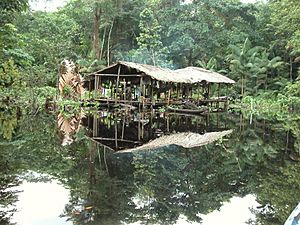Pre-Columbian period in Venezuela facts for kids
The Pre-Columbian period in Venezuela is about the time before Europeans arrived. It covers the history of the native people of Venezuela before the Spanish came in the 16th century. This era is also called the Pre-Columbian era.
Contents
Early Inhabitants of Venezuela
Archaeologists have found signs of the first people in Venezuela. They discovered leaf-shaped stone tools and scraping tools. These were found near the Pedregal River in western Venezuela.
Later hunting tools, like spear tips, were found at a site called El Jobo. This site is in northwestern Venezuela. Scientists used radiocarbon dating to find out these tools are very old. They date back to between 13,000 and 7000 BC.
Other important sites from this time include Taima-Taima and yellow Muaco in Falcón. The people living then shared the land with huge animals. These included giant sloths called megatherium and armored creatures like glyptodonts.
The Meso-Indian Period: New Ways of Life
Archaeologists call the time from 7000-5000 BC to 1000 AD the Meso-Indian period. During this time, people started to change how they found food. They were no longer just hunting large animals.
Instead, they began to gather different foods and hunt smaller animals. This period also saw the first tribal groups forming. People started to live in more organized communities.
The Neo-Indian Period: Before European Arrival
The Neo-Indian period began around 1000 AD. This era continued until the arrival of the Europeans. It was a time of further development for the native peoples of Venezuela.
Life Before the Spanish
We don't know exactly how many people lived in Venezuela before the Spanish arrived. Some experts think it might have been around a million people. Many different groups lived here, like the Arawaks, Caribs, and Timoto-cuicas.
Sadly, the number of native people dropped a lot after the Spanish arrived. This was mainly because new diseases from Europe spread quickly.
People in Venezuela grew two main types of food. In the west, they grew maize (corn). In the east, they grew manioc (cassava). Large areas of the Llanos plains were farmed. They used methods like slash and burn and also settled farming.
The native people of Venezuela also knew about crude oil and asphalt. These would seep up from the ground. They called this thick, black liquid mene. They used it for medicine, as a light source, and to seal their canoes.
Spanish Arrival and Resistance
In the 16th century, Spanish colonization began in Venezuela. This led to a decline in the population of many native groups. One example is the Mariches, who were descendants of the Caribes.
Native leaders, called caciques, tried to fight back against the Spanish. Famous leaders like Guaicaipuro (born around 1530) and Tamanaco (died 1573) resisted the newcomers. However, the Spanish eventually defeated them. Diego de Losada, who founded Caracas, was the one who put Tamanaco to death.
See also
 In Spanish: Prehistoria del territorio venezolano para niños
In Spanish: Prehistoria del territorio venezolano para niños


